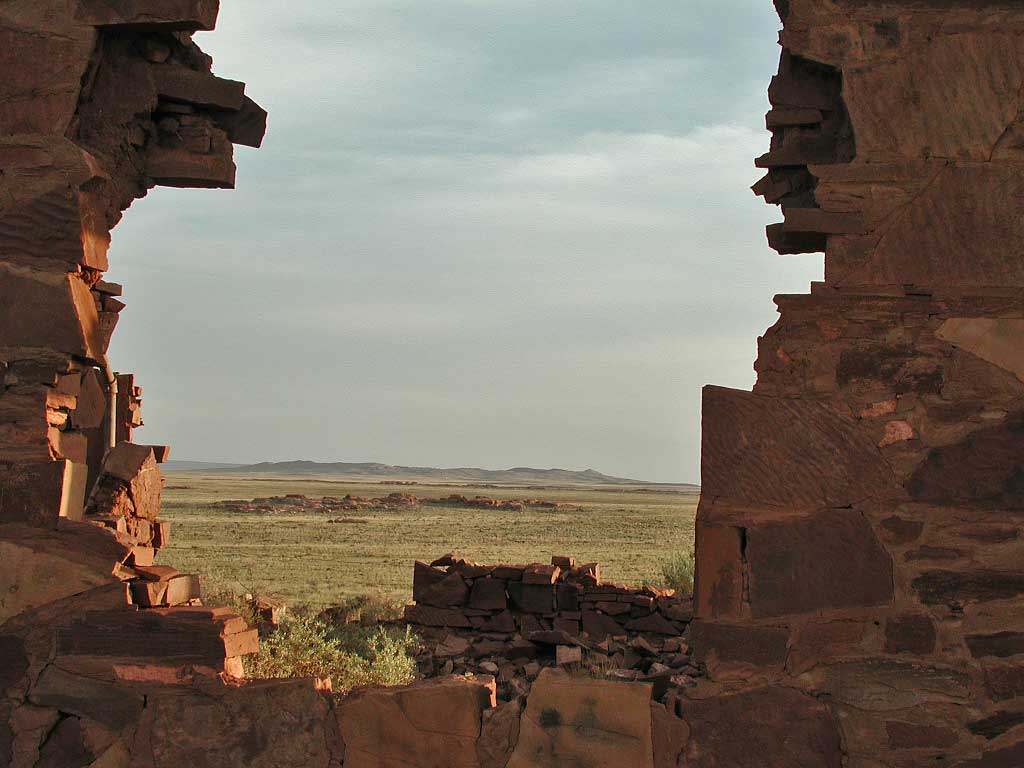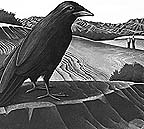



Near Winslow, Arizona, not far from Meteor Crater, on a deserted section of road that was was once part of a great paved hightway known as Route 66, and easily observable from the interstate, I-40, sits the ruins of a structure that is now not much more than a few crumbling red sandstone brick walls. The structure, known at onetime to locals as "the observatory," looks as though it could be a thousand years old, but in actuality was constructed sometime in the 1930s and taken over by Nininger in 1946 to house the American Meteorite Museum, the first privately owned meteorite museum in the world. It's founder and curator was Dr. Harvey H. Nininger, and for Nininger, from October 1946 to September 1953, the building served not only as the museum, but as his home, workplace and lab.(see)
Harvey Harlow Nininger born Jan. 17, 1887 at Conway Springs, Kansas, married in 1914, and had 3 children. He received a B.S. degree in 1914 and honorary D.Sc. in 1937 from McPherson College.
Honorary D.Laws from Arizona State Univ., 1963.
Prof. Biol. at LaVerne College, 1914-18.
Field agent, Bureau of Entomology, U.S. Dept. of Agriculture, 1918-19.
Prof. Biol. at Southwest Col. (Kans), 1919-20.
Prof. Biol. at McPherson College, 1920-30.
Curator meteorites, Colo. Museum of Natural History, 1930-46.
Director, American Meteorite Museum, Meteor Crater 1946-1953
---------------
Museum relocated to Sedona, Arizona, 1953-60.
Consultant, Investigator, and Lecturer on meteorites, 1960-1986.
After 1930, H.H. Nininger specialized in meteorites, did very extensive research of the famous Meteor Crater near Winslow, Arizona, accumulated perhaps the most outstanding meteorite collection ever achieved, published books on the subject, and achieved international fame in that area of study.
I was around ten years old the first time I met Dr. Nininger. My mother had died some years previously and after a series of events I ended up living with my Uncle. My uncle spent a great deal of time traveling in and about some very remote sections of the Arizona and New Mexico deserts interacting with the indigenous populations thereof because of various, as he called them, "art" related ties he had with them. On many of those travels, primarily funded through the financial resources of my Stepmother, he took me with him. We went to see the then unknown Pendejo Cave, where traces of man's existence in the Americas are thought by some to date back 50,000 years. We visited the so-called crash site of the mysterious downed object later related to the Roswell UFO, walking much of the then nearly fresh debris field. We stayed days, sometimes weeks at such places as Meteor Crater, as well as taking the hazardous backbreaking trip to Fajada Butte, and under the auspices of a tribal spiritual elder, journeying to the so-called now, but secret then, sacred Native American Sun Dagger site, even sleeping in the remnant remains of an ancient room 400 feet above the valley floor along the cliff-side ledge of the butte on the night before the summer solstice.
When we were passing by or staying at the Meteor Crater we visited the American Meteorite Museum and its curator Dr. Nininger, who my uncle knew, many times. Visiting the museum is one of my fondest childhood memories. Although the first time I visited the museum it was still in the process of completion as Nininger was only just taking the structure over, I still remember it well because it was also the first time I ever saw so many meteorites in one place and actually be given the chance to hold meteorites in my bare hands. When no one was looking I even stuck a piece of one in my pocket that Dr. Nininger said had once been a sacred object of the Indians, having been found buried in the ruins at the nearby Elden Pueblo. After a couple of days I was so racked with guilt I broke out in a rash or hives of some sort and in tears admitted to my uncle what I had done. He made me slip the meteorite back amongst the other meteorites just as I found it, telling me for a person such as myself even white light shields could not ward off the ramifications of such actions related to a culture's holy item, even if that culture no longer existed. Unless my uncle told him, to my knowledge Dr. Nininger never gained knowledge of my "youthful indiscretion."[1]
Dr. Nininger also visited our camp several times. On one of those occasions he met Dr. Lincoln La Paz, himself a renowned meteor hunter, and also an acquaintance of my uncle. Matter of fact my uncle spent most of the time keeping the two them at arms length as they had strong differing views as to how meteorites should be collected and if they should or even could be "sold" to the public. True, I was just a boy at the time and didn't get the full and total gist of the situation, but La Paz felt they should not be, Nininger held an opposite view and they discussed it at length, sometimes very animated and loud. Please see Footnote [2].
Oddly enough, a few years later La Paz, because of his knowledge of meteors and meteorites, was called in by the U.S. government to assist in the investigation of the so-called Roswell Incident in an apparent attempt to determine the alleged downed object's trajectory. La Paz recruited my uncle to help because of his bio-searching skills and intimate knowledge of indigenous plants of the desert southwest. Many of the plants appeared to be burnt or wilted along the suspected trajectory as well as moved, replanted or replaced and La Paz wanted my uncle's expert opinion to determine the reason behind it. My uncle's participation in the endeavor never seemed to bother Dr. Nininger much, but he pooh-poohed La Paz a great deal saying, "a man of his reputation should never be taken in by such rubbish." Another person periphery to the whole Roswell Crash who I have been told gave me my first prospector's pick, was a wild and wooly but highly regarded amateur rock hound and Pothunter that my uncle knew for a variety reasons, named William Lawrence Campbell, but known as Cactus Jack. He claimed in discussion to have worked for and assisted Dr. Nininger sometime after World War II cataloging meteorites and scrounging meteorite scraps from the Canyon Diablo scatter field surrounding Meteor Crater.
For more information regarding Dr. Nininger there is a fascinating written transcription from an oral interview done by the FLAGSTAFF PUBLIC LIBRARY ORAL HISTORY PROJECT, Interview number NAU.OH.28.34, dated January 28, 1976: Nininger Interview. The interview includes an interesting section on Nininger's view of UFOs which in a way skirts around his "a man of his reputation should never be taken in by such rubbish" quote cited above regarding La Paz.
Dr. Nininger died in 1986. Dr. La Paz, born the same year as Nininger, died in 1985, the year prior to Nininger.

 |
THE BEST OF CARLOS CASTANEDA |
| <<< PREV ---- LIST ---- NEXT >>> | |
THE GREAT 1947 SUNSPOT, ROSWELL, AND CORONAL MASS EJECTIONS
THE METEOR CRATER METEORITE: WHAT HAPPENED TO IT?
ON THE CRATER FLOOR: Meteor Crater, Arizona
MEDITATION ALONG METEOR CRATER RIM
ZEN, THE BUDDHA, AND SHAMANISM

Cattell, Elizabeth, et al.
"American Men of Science"
11th ed, Physical & Biological Sciences (1966)
Museum ruin graphics courtesy:
DAVE'S SPACE JUNK
(site no longer active)
Dr. Nininger graphic courtesy:
STEVE SCHONER
American Meteorite Survey
P. O. Box 1003
Flagstaff, AZ 86002
DESCRIPTION FROM THE BACK OF THE BOOK:
In this remarkable book, Dr. H.H. Nininger, often called the world's foremost meteorite expert recounts the excitement of his long love affair with "falling stars"—those "stones from the sky" that rain down on the earth from outer space in great but little-known profusion.
Fifty years ago the science of meteorites was at a low ebb. Nothing much had been done since 1900. It was Dr. Nininger's keen interest, however, that brought about a resurgence in an old science. His efforts, described with straightforward ease, account for more than half the falls recorded in the 20th century. His common sense, ingenuity, and persistence helped him develop techniques for locating a meteorite observed falling in an area 400 miles wide; he tells how he enlisted the help of farmers and ranchmen of the western plains; he recounts how, out of enthusiasm, he traveled thousands of miles to train people to find and recognize stony or iron meteorites of various sizes. At one time Dr. Nininger's personal collection of meteorites, housed in Sedona Arizona, where he lives, was considered one of the world's greatest. He is the the author of a number of books on subject and has lectured widely.
This personal account of a field scientist in action should be of very special interest to amateur and professional geologists and astronomers alike, to "rock hounds" and to anyone with the slightest scientific curiosity.
Emerging from the Oklahoma cotton fields, Harvey Nininger was overwhelmed at the sight of a state normal school. He was granted conditional enrollment and soon found himself at the head of his classes in science. Seven years later he graduated from college with honors and a teaching position. Hs first view of a great fire-ball plunged him headlong into an exciting new field, meteoritics, and again he was soon out in front. Thirty years later he has a world wide reputation.
Proud of their three children and nine grandchildren, he lives in Sedona, Arizona [in 1972], with his wife and co-worker, Addie, who for 58 years was always an indispensable partner.
THE CAUSE FOR MY UNCLE'S CONCERN: The more pure and
spiritually developed a person is --- especially if they are actively
working towards real spiritual advancement OR it is known in the ripples of the DHARMADHATU that they will be --- the more attention
they will attract from the negatives to pull them down (see Mara). In other
words, the potential of any aspirant generates their level of
negative opposition, plus their level of positive assistance,
as set by Karmic Law. This is the natural way of things, and
is part of the reason why real long-term spiritual development
is so difficult. And this is also why those that achieve any
significant level of spiritual / psychic development usually
live fairly difficult lives, or have a painful past.
SOURCE: White Light Shields
DHARMADHATU: According to the correct view of Dharmadhatu all dharmas in the past, all dharmas at present and all dharmas in the future are all together in the Dharmadhatu. It is neither limited by space nor by time. Ordinarily people can experience only a minute part of all dharmas at present, and therefore people sustain the view that dharmas in the past are gone and future is unpredictable. If one practices according to Buddhist teachings and thereby comes out of the bondage of the fixed view of the Space-Time Framework, then it is possible to experience or witness dharmas in the past as well as dharmas in the future.
FOOTNOTE [1]
THE WANDERLING, BEGGARMAN, THIEF